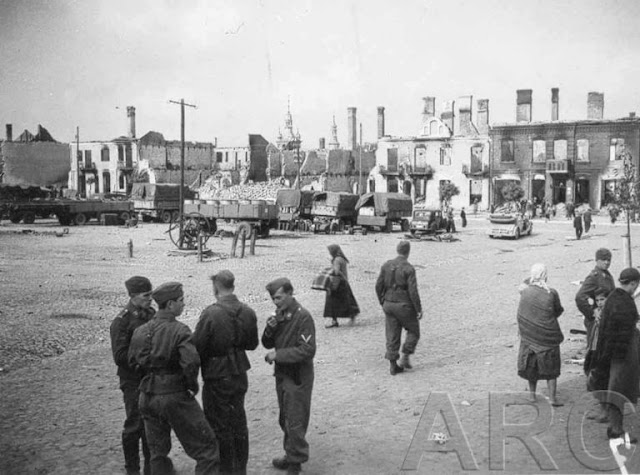9: "Ghettos"
At a top secret meeting in Berlin on September 21, 1939, Reinhard Heydrich told the commanders of several SS operational groups in Poland that his "ultimate aim" for Polish Jews must be kept "strictly secret." Meanwhile, he wanted large areas of western Poland to be "cleared completely of Jews," and elsewhere the Jews were to be confined in special areas of cities and towns. Any Jews living outside the designated area would be forced to move into the confined area, which was to be called a "ghetto."
Ghettos had existed, as Jewish quarters of towns, hundreds of years earlier, but unlike there medieval predecessors, the new ghettos were to be surrounded by barbed wire, brick walls and armed guards. The ghettos were to be located in cities on railway junctions or along the railway, "so that future measures may be accomplished more easily."
The first ghetto was set up in Piotrkow on October 28, 1939. Jews living throughout the town were forced to leave their homes and move into the ghetto area. It was desperately overcrowded and the Germans kept food and medical supplies to a minimum.
Other ghettos were set up throughout the region, the two largest being in Warsaw and Lodz. From fifteen towns and several hundred villages in western Poland, the Germans expelled 40,000 Jews into Warsaw in the course of a few weeks. A further 38,000 were expelled from towns and villages elsewhere in Poland into the Lodz and other ghettos. It was -- thus far -- the largest forcible uprooting of the Nazi era. Those expelled from their homes lost their livelihoods, and almost all their possessions, overnight.
Tens of thousands of Jews were also expelled from Greater Germany into Poland, sent to a region -- known as Lublinland -- where they were left, without resources, to fend for themselves. These expulsions began on October 17, from Vienna, Prague and the Baltic port of Stettin. The deportees were sent in locked passenger trains under SS armed guard. Their homes and property were taken by Germans. Many children froze to death on the journey.
Adolf Eichmann met the deportees on arrival and told them: "There are no apartments and no houses -- if you build your homes you will have a roof over your head. There is no water. The wells are full of epidemics. There's cholera, dysentery, typhus. If you dig for water, you'll have water."
German soldiers opened the luggage of the arrivals, and took whatever they wanted. Many other Lublinland deportees died of starvation soon after their arrival. Inside the Warsaw ghetto, deaths from starvation were to reach two thousand a month by the beginning of 1941, a thousand a month in the Lodz ghetto. Six months later, these high deaths rates had doubled.
--
With the creation of the ghettos, Jewish communities of tens of thousands of people were cut off from contact with the outside world. "There were no radios, no telephones, no newspapers," wrote Mary Berg in her diary on November 20, 1940. With the steady increase in hunger, the preservation of morale found many forms. One of these was education. In every ghetto, efforts were made, in the greatest secrecy and amid continual danger, to continue with the schooling of youngsters. In the Warsaw ghetto, Janusz Korczak, an educator of distinction, ensured that in the orphanage of which was the director, classes continued as normally as possible.
To maintain the morale of the adults, an enormous effort was put into providing concerts and theatrical performances. In the Lodz ghetto, internationally acclaimed conductors and pianists performed amid the privations and hardships.
--
Despite all their efforts, the Jews could not win the fight against the deliberate German policy of starvation. In Warsaw, before the Germans embarked on a policy of deportation to death camps, almost 30,000 Jews had died of starvation between July and December 1941, and a further 20,000 between January and June 1942.
In Lodz, the deaths from starvation totaled more than 12,000 in the twelve months before the deportations began in January 1942. Jews from more than fifty towns and villages around Lodz had been forced out of their homes and taken to the Lodz ghetto. Jews from Germany, Austria and Czechoslovakia were also deported to Lodz, where space had to be found for them in the already overcrowded and hungry ghetto.
The German ration scale ensured starvation. In the occupied towns, Poles were allowed less than half the daily calorie intake of Germans. In the ghettos that were part of those same towns, Jews were allowed less than half the calories allowed to Poles. The most that Jews were ever allocated -- those who were working in the Lodz ghetto workshops -- was 1,800 calories a day. A working person needs at least 2,000 calories a day. By the end of 1941, the average intake allowed in the Lodz ghetto had fallen to between 700 and 900 calories. In some ghettos it was even lower.
Rudy Janek -- Red-headed Johnny -- was a Pole who served the Germans as a ghetto guard. He had also found a way of making money from the Jews. Having smuggled twelve hens into the ghetto, he was paid by the Jews each time the hens laid eggs. When the hens were found by the Germans and confiscated, Janek decided to avenge himself for his loss of revenue by killing two Jews for each hen.
Thirty-five people were killed by the guards in the month of July 1940. Rudy Janek killed twenty-four of them.




Comments
Post a Comment